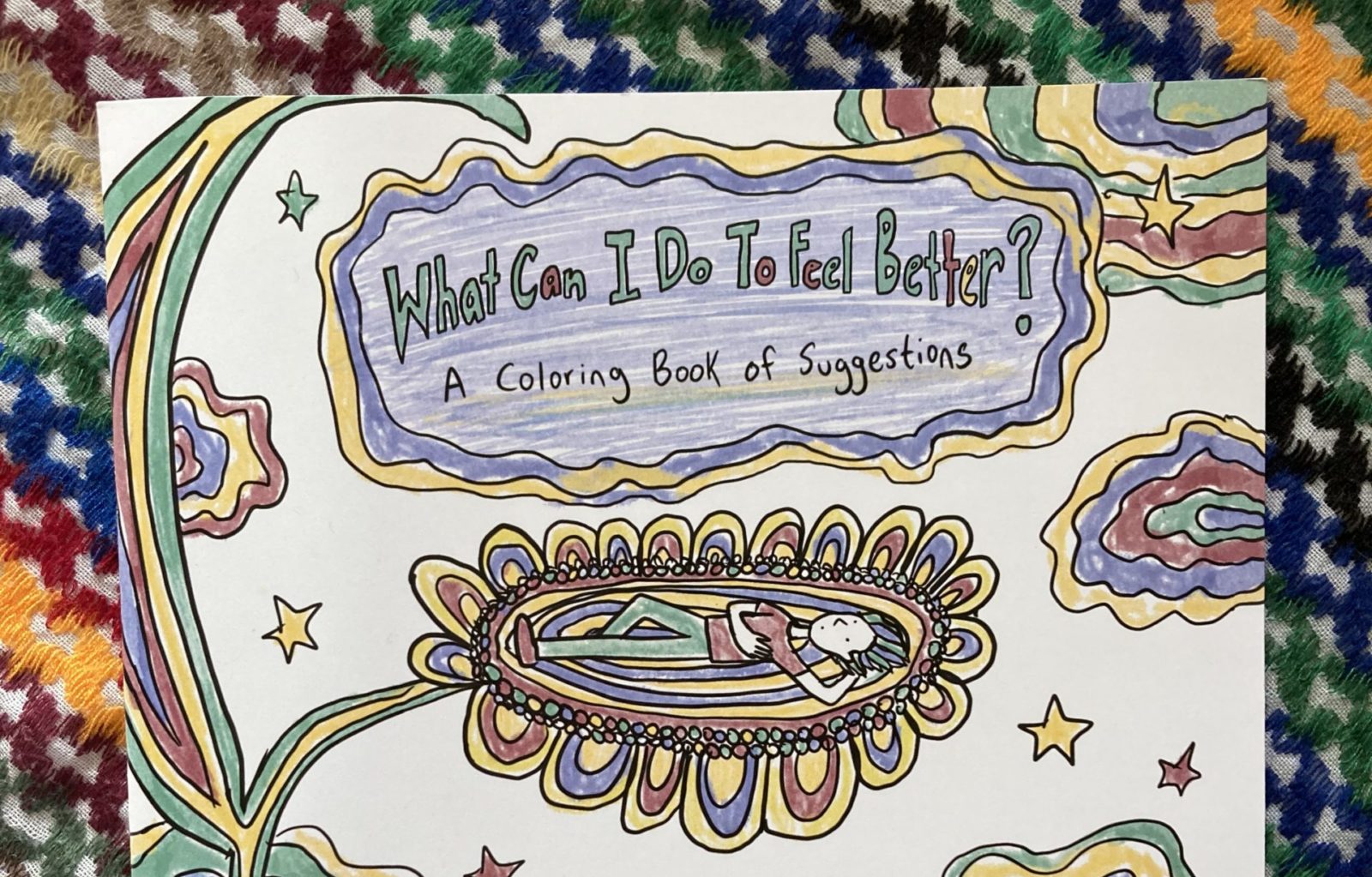This July, Grace Devine, SPACE summer Storytelling and Engagement Intern with Bates Purposeful work, sat down with Josie Colt and Myles Bullen to discuss the What Can I Do to Feel Better Book Tour, supported by a Kindling Fund Grant. Administered by SPACE, The Kindling Fund is one of thirty-two nationwide re-granting programs established by the Andy Warhol Foundation for the Visual Arts.
Can you provide some background behind the inspiration for the What Can I Do To Feel Better Coloring Book and Book Tour?
Myles Bullen: The project started in the darkest pit of the Winter and quarantine. I was feeling really depressed, sad and alone. I made a Facebook post that asked “what do you do to feel better” and I got a ton of responses. I got in touch with Josie and we talked about how it would be a really cool idea for a book. Then I wrote a poem based on those responses and a little at a time I sent excerpts of the poem to Josie. I would send them a couple of lines and then they would draw something that reminded them of those lines. After a while we had enough to make this coloring book.
Josie Colt: Once we had finished the first draft of the poetry and the illustrations was when we realized that it could double as a coloring book. The coloring book element added another tool of something you could do to feel better. Myles and I had our first real interaction when they came and got a portrait at the farmers market. That’s when Myles mentioned the idea and we started brainstorming. We had our first big collaboration on Myles’song Swallowing Bruises that I did the animation for. Our next project was the coloring book.
Something that really stood out to me about the book tour is that it allows people in the community to create art with you. This framework is something I have noticed in both of your artforms. You both disrupt the norm around the audience being distinctly separate from the art. Can you speak to the experience of allowing the community to be fellow collaborators in this project?
MB: Yeah it was cool to see. I love that you said that we let the community kind of shape the experience. Some people came intentionally because they saw a flyer and came to color and then other people just walked by and engaged with it in various ways. Some people just drank coffee and listened to conversations, any and all were included and welcome to hang out with us.
JC: I really loved how this coloring book series of events ran itself in a way. We had the supplies, and we facilitated the setting, but people just came and shaped the experience with us. In that way it was really a community collaboration. Each day of collaboration was different based on who came and shared the space with us. A lot of people brought art supplies, we ended up having way more art supplies in the end then we did in the beginning just because people were like, “I have way too many crayons at home”.
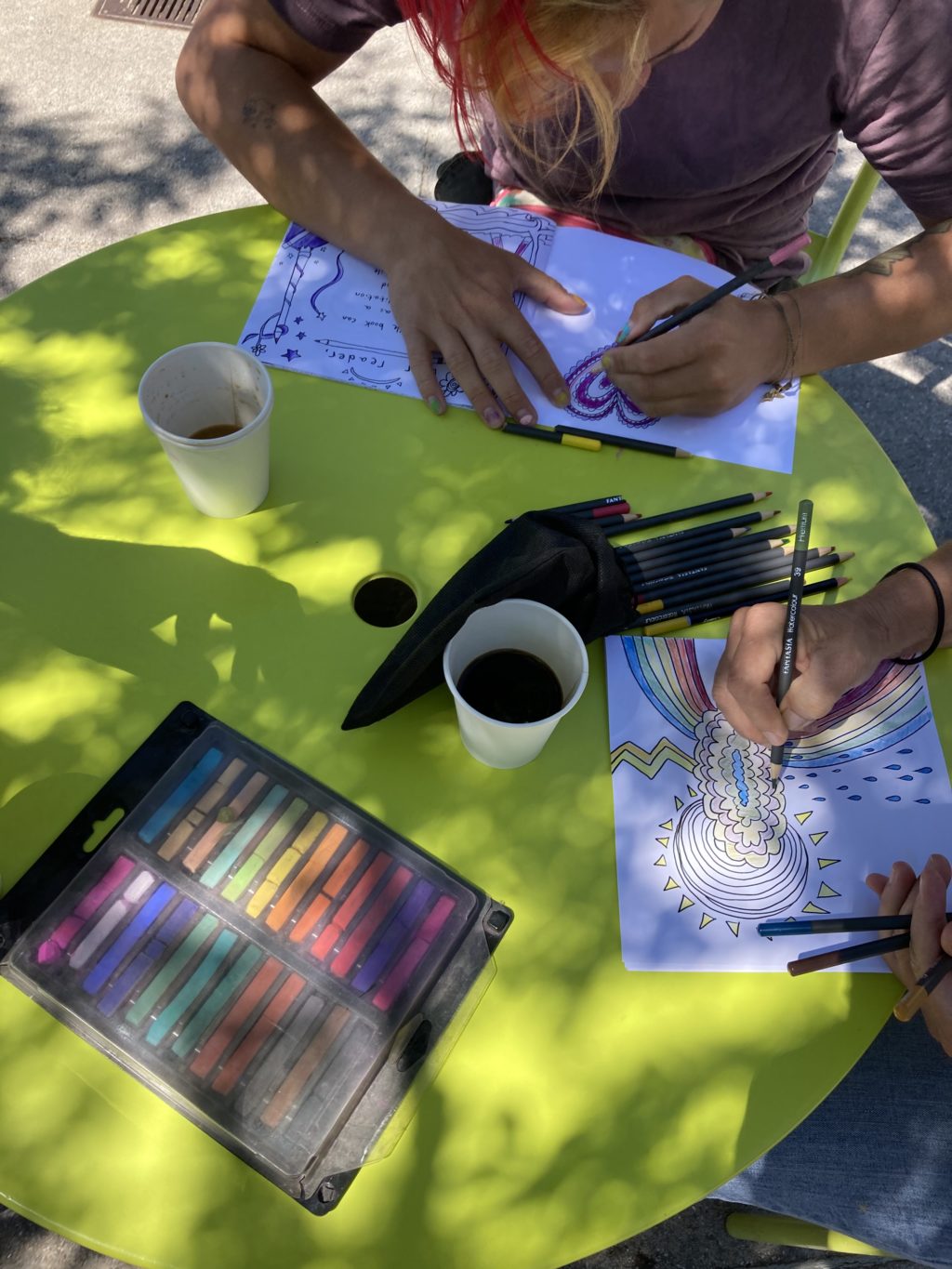
JC: I think another thing that happened that wasn’t exactly coloring but was very collaborative was we had this banner that we hung up that said in big lettering, “What Can I Do to Feel Better?” We strung it between a couple trees outside Congress Square Park with some sharpies attached to it and let anyone walking by contribute to it. By the end it was quite full of suggestions and words.
MB: Yeah, it was completely full.
JC: There were so many suggestions we gathered through that collaborative banner. It was nice because it gave people an opportunity to participate if they did not have time or desire to sit down and color.
MB: Our original idea for the banner was to promote the event so people would know it was going on. Essentially for it to act as a sign, but then we turned it into this collaborative thing. The banner ended up feeling separate from the event in a way, I feel like it ended up reaching more people because it was more accessible. I like what Josie said about the timing, you could take ten seconds and write something real quick and I think that was a huge draw for people.
JC: In a way I am not sure if most people realized that the coloring and the banner were part of the same thing.
MB: Yeah, they’re kinda different things.
JC: But secretly the same.
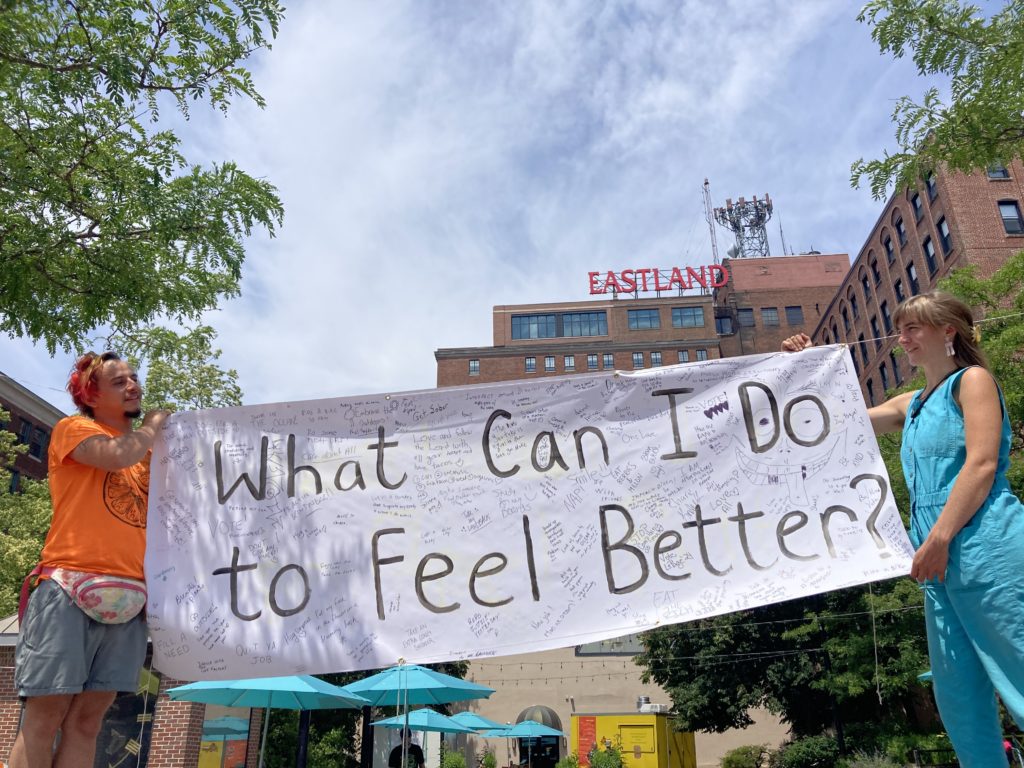
The title of your coloring book is, “What Can I Do To Feel Better?” This question holds elements of vulnerability and a desire to have authentic conversations. Can you speak on inviting this conversation with strangers through this book and your events?
MB: For this event series, we did not directly ask people the question. Rather the book provides suggestions and the banner silently asks you and you have the choice to respond or not. Outside of the event, I think the question can throw a lot of people off guard when someone opens a conversation with a deep question. I think a lot of conversations with strangers are like “how are you doing” without actually caring about how people are doing. We often ask that question on autopilot or we talk about the weather. If we do spark a question with a stranger that’s deep and authentic it can throw people off guard in a good way. The question, “what can I do to feel better?” in a way allows people to feel like they have control and power over their own lives.
JC: I think the question, “what can I do to feel better?” is interesting because in order to answer it you have to have felt low yourself and have strategies for what you yourself do to feel better. This specific question directs the suggestions to the other person. So it invites people to share and reflect in an indirect way, allowing them the chance to feel like they’re helping another person who needs to feel better. When in reality, we all pretty much always need to be thinking about how to feel better.
JC: I do think that in the events themselves there was an element of vulnerability even if conversations were light. Just sitting and spending time with each other felt vulnerable. I definitely heard people reflect on that, this realization that we don’t have to be afraid of each other. We can just spend time with strangers coloring in the park and everyone who stopped by seemed to benefit from that or enjoy it. Sometimes people directly said things about that, like “I really needed this today”. There was an older woman who came by and she told us that she tries to do something that scares her every single day and that this was the thing she did that day. That was really sweet.
JC: We were coloring on the Friday when we heard the news about Roe being overturned. The older woman was there and it was a nice space to be together and to reflect. In my art, I always love how sharing something vulnerable and scary for me always ends up feeling good. What’s so meaningful is hearing people respond to it with a “me too” response, being able to relate and feeling like you aren’t alone in your experiences.
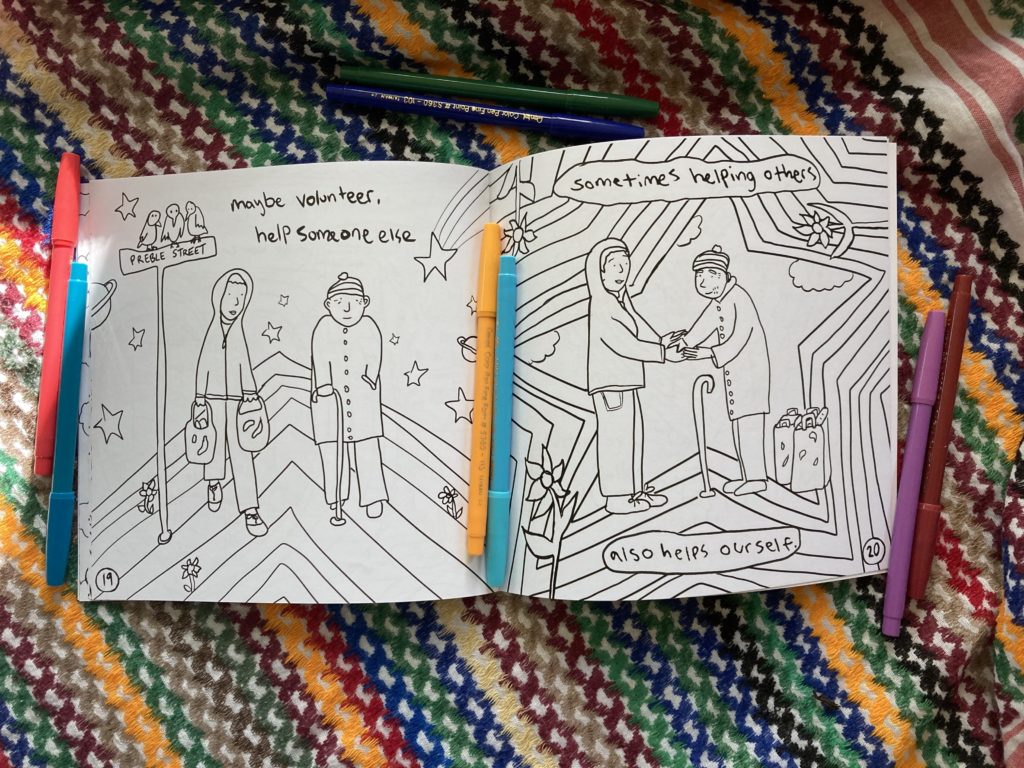
Are there any other memorable interactions you would like to share from the book event series?
MB: Something that was memorable is the length that people sat down. I had 30-40 minute conversations with people that I had never met. They would just sit down and because it was clear that this was a space for engagement. People felt safe enough to sit down and talk and I really think that is an amazing thing. We had so many different types of people there, ages ranging from 2-80. It was really fun to see people get excited about doing this childlike thing together, coloring. I remember one woman, probably in her thirties, was like, “I haven’t just sat down to color since I was a kid and it feels really good”. There was this other person I was talking with who was like “I haven’t had this much fun in months”. Hearing people express that this small activity in their day, this blip in their life, felt good meant a lot. It seems like a rarity now that people just get together to do things just for fun.
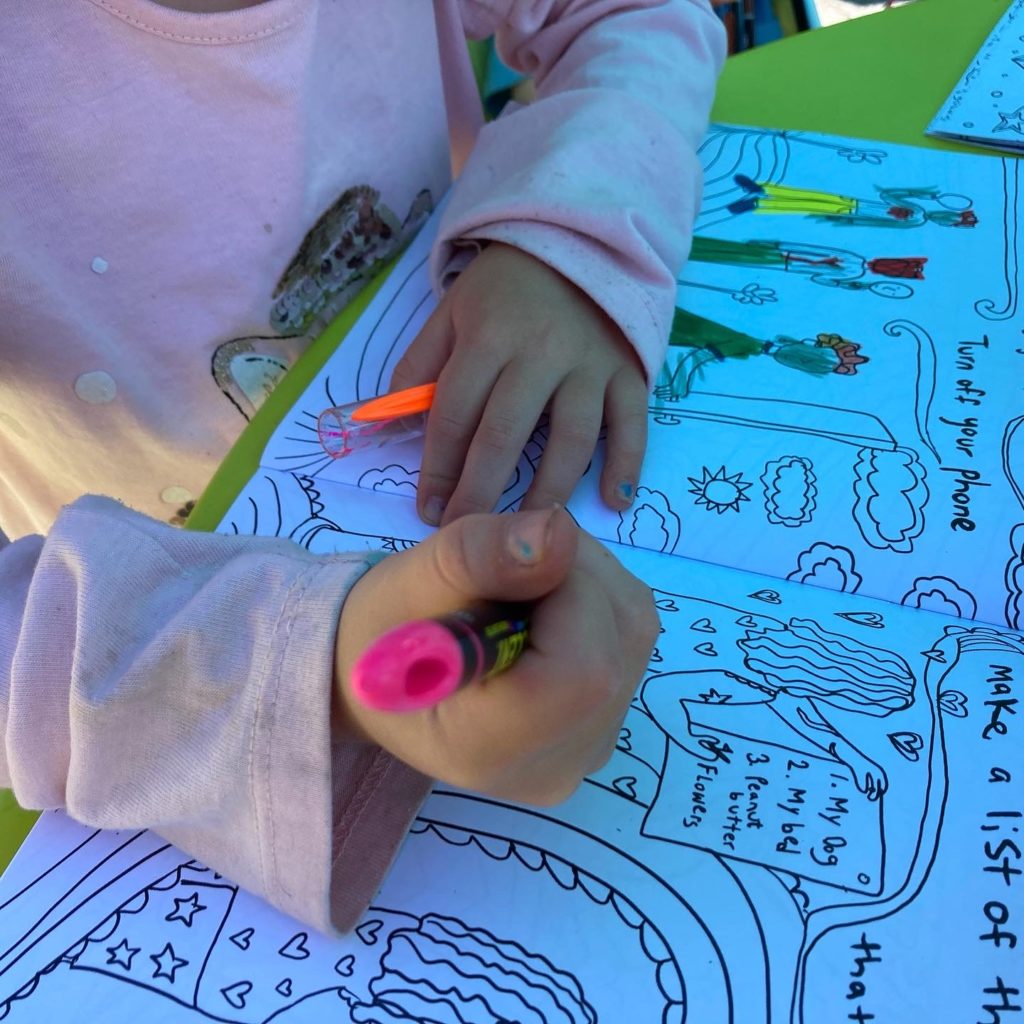
MB: I think a magical realization that I had was the less Josie and I actually did, the more people were engaged. We set up everything in the morning and we didn’t do anything else. We didn’t prompt people really, we didn’t lead people. We just kept a space open for people to express themselves and engage with us and I think that is where the magic happened. Just letting go of control allowed people to feel invited to sit with us
JC: Yeah, Congress Square Park is a really cool space for that because it’s so central and so public. People know that it’s there for everyone.
What are some unexpected outcomes of this project you would like to share?
MB: We engaged with at least 200 people between the banner, coloring the books, and chatting with people hanging out in the Park. We were thinking a lot less than that, we were thinking maybe like 5 or 10 people maybe.
JC: Yes! We were like this is a success if one person comes.
MB + JC: (Laughs)
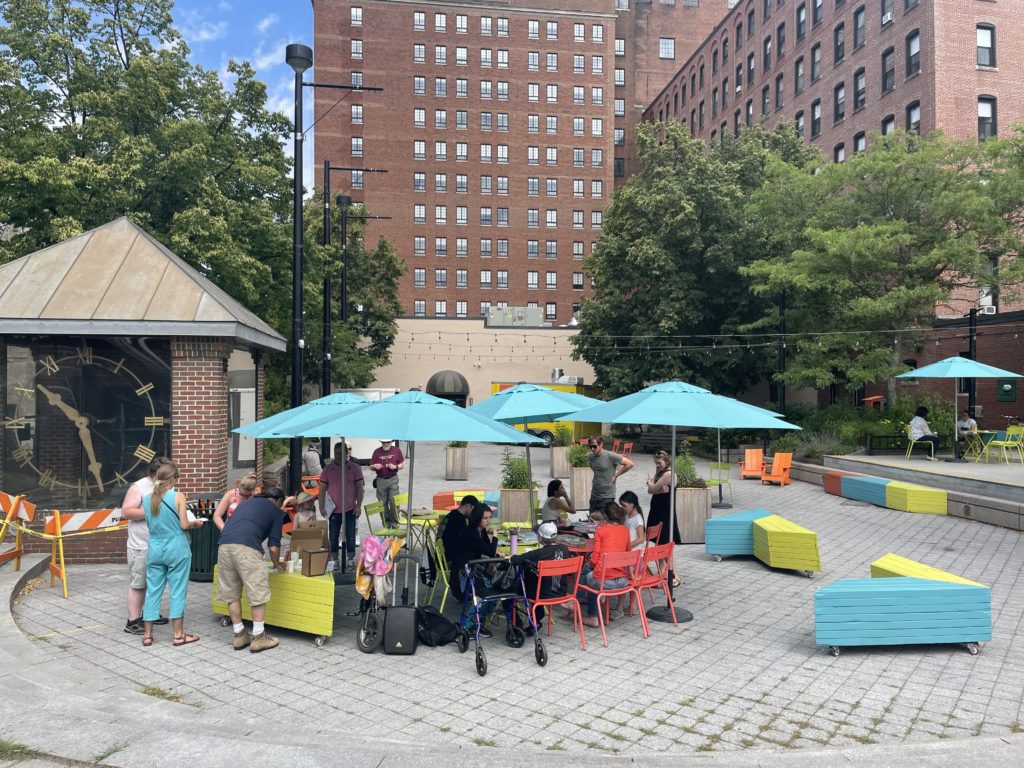
MB: The fact that we engaged so many people was really surprising and rewarding. What was really cool for me is that we had a group of people that came to every event and that felt like we were building a healthy routine in the community. It wasn’t a one-off event that affected somebody for a single moment. Some people stayed the whole time, and then they were the first ones there the next week.
JC: Since the events as I walk or bike by I will see people I recognize and I am like, “oh I should be coloring over there right now!”
MB: Yeah, I didn’t think I would be as sad as I was at the last event. I was really sad that we wouldn’t be doing it the next week. Also, I was surprised how well Josie and I facilitated and worked together. How easy it felt and how much we both enjoyed doing it. It’s different making art and facilitating a space. Those are two very different things. I know Josie and I could make art together and that we are friends, but I didn’t know how being co-event organizers was going to go. So the fact that it went really well and felt really easy was also a pleasant surprise.
JC: I agree, it was pretty smooth sailing.
That was something I was interested in, both of your artistic disciplines have given you experience in engaging the public through your art. I would love to hear more about your facilitating experiences and approaches for this project.
JC: Even though I don’t think of myself as having a ton of experience facilitating groups, I suppose I am always facilitating some experience or environment when I do portraits or with these coloring events. I feel very comfortable and most confident in small groups or one on one interactions. When I do portraits it’s always a very direct personal experience. That does come more naturally for me, being able to connect in a kind of intimate, one on one way. As for group teaching or facilitating, I have less experience with and confidence in. It was really fun with the coloring, I felt like I was interacting and talking to people one on one within the group while also having my eye on the whole situation. Making sure everyone was feeling okay, had enough coloring supplies, knew where the coffee was- that was really sweet to experience.
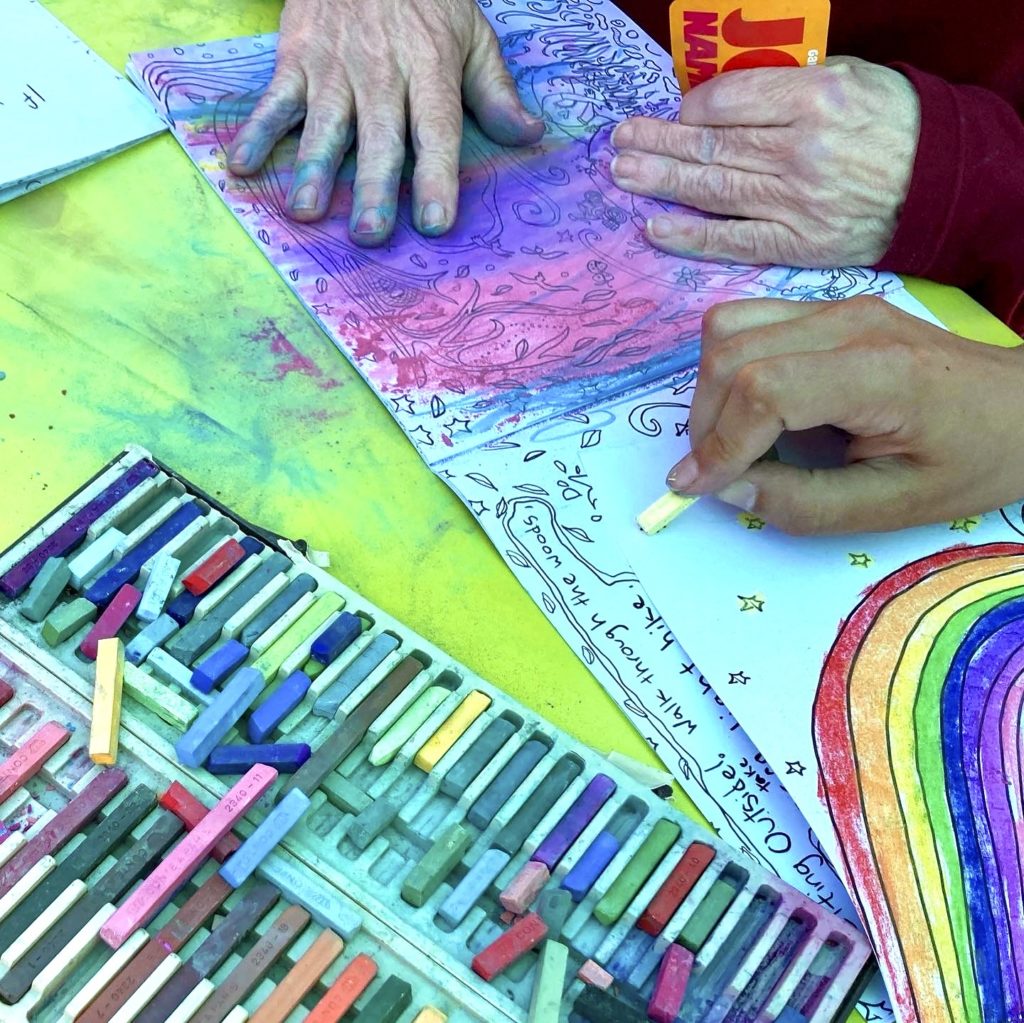
MB: I have years and years of experience teaching and facilitating groups. So I feel like it’s a strong suit for me. It’s a skill I have developed over years. I used to teach workshops at The Telling Room. They trained me how to engage groups of people and how to work on group dynamics of youth, but so much of that translates regardless of age. I love facilitating spaces for people to be creative, loud, weird, funny and eccentric. Even with writing groups, which are usually pretty quiet, there is still a level of vocal expression by sharing whatever we wrote. But this was one of the quietest, most tame workshops and spaces I have helped facilitate. A large number of the people who came didn’t even engage with Josie or me. They just got a book and started coloring with their friends or by themselves and didn’t talk to us at all really. So there was a lot of silent stuff happening, a lot of internal things. We can’t really gauge the impact of this project on people who didn’t engage with us directly, but we know they did engage with our art. That was a unique experience for me. Usually my goal as a facilitator is to talk to everyone and make sure everyone’s voice is being heard. This was a totally different situation because if you wanted to come and be quiet that was encouraged and if you wanted to share you could do that too. That was a unique type of facilitating that I hadn’t experienced before.
JC: It brings it back to the collaborative nature of this project, our style of facilitating was more about collaborating with the whole group.
Was that something you expected to happen, it to be a more independent experience within a collaborative framework?
JC: It didn’t surprise me too much, but I guess after the first day I had a pretty good idea of what to expect. Before the first event I was curious about our role. It’s such a straightforward task, coloring in these coloring books, so there’s not a lot of direction needed. Once that was made clear, I was like okay I don’t need to worry too much about people.
MB: I noticed that before people started coloring they felt a little more guarded and the conversations were more surface level, but that changed once we started coloring. Everyone was looking down, focusing their eyes on filling in these spaces with the colors of their choice. It caused their dialogue to totally open up and it became a lot more casually vulnerable. I felt that way about myself too, when I was coloring, I felt so at ease to talk about anything. There is a visual goal to focus on while also engaging in a dialogue. That juggling of multiple focuses frees up any sort of blockage that would be there in speech.
JC: Yes, it’s like a buffer in that way. You don’t have to be directly looking at each other. You are still very present with each other when you’re coloring, but you have this activity that acts as an element of protection.
MB: I think I was also more approachable because I wasn’t looking in their eyes. I felt like it gave people more permission to be honest and real.
JC: Totally, it’s like sneaky group therapy. No one would have agreed to that.
MB: Right, this was kinda a way into having deeper conversations casually.
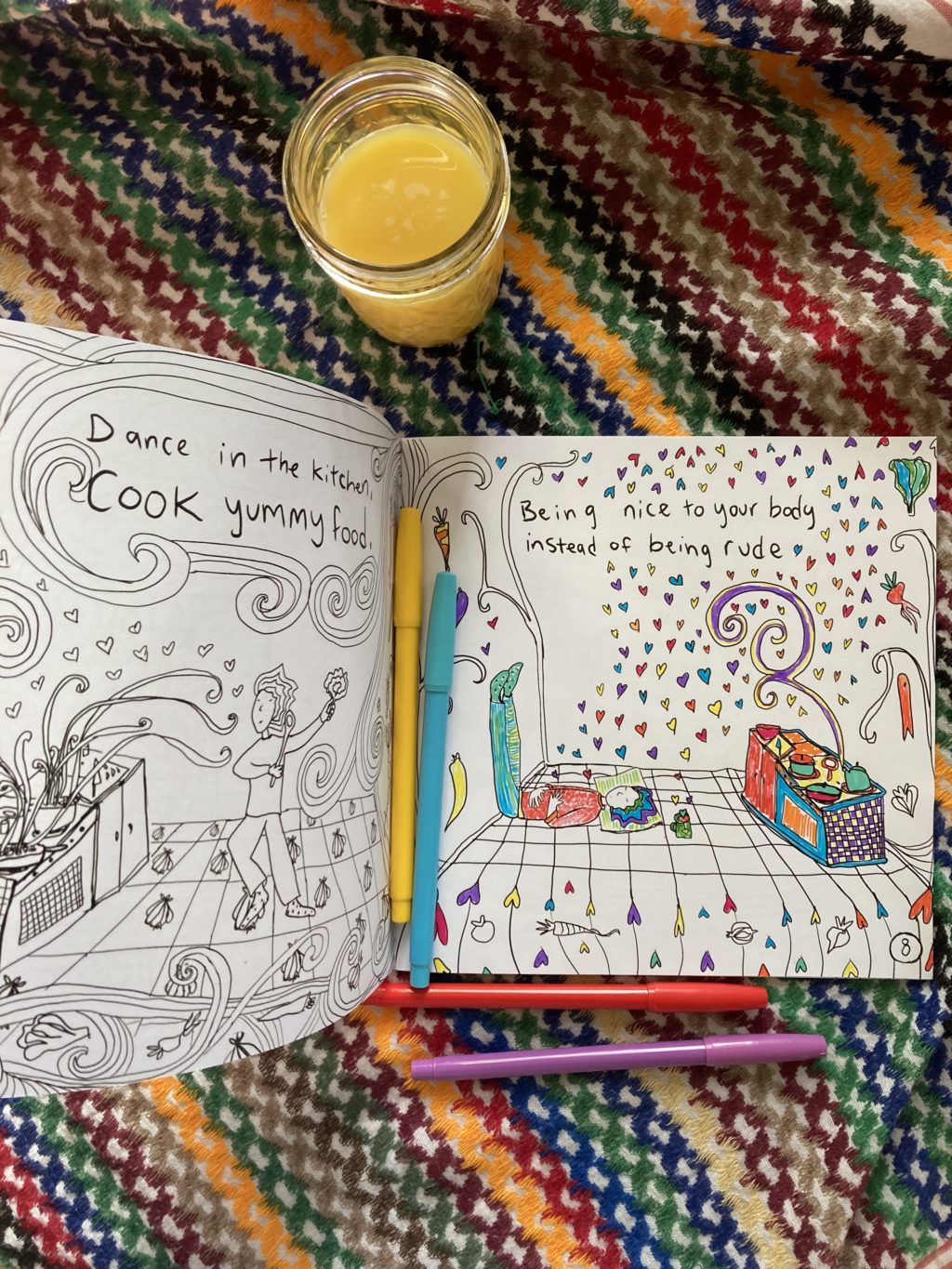
MB: Josie and I kinda split up across the space. Josie was at the tables towards the center of the park and I was up towards the sidewalk near the banner. Josie was near the coloring books and I was just sitting at a solo table with one empty chair and one extra book and some coloring supplies and anyone who would walk up to me I would say, “hey you can go and color”. Sometimes they would go down and sit with Josie at the bigger table with more people if that looked like something they wanted to do. People who wanted to sit with one person would sit with me. That was an interesting dynamic, we didn’t intend on having those two options. I wanted to sit at the front to let people who were walking by who might be confused that they were welcome to come and color with us. That was my goal. But it ended up being this alternative option, people could choose if they wanted a one on one interaction or a group interaction and both of those were physically and visually available.
Is there anything else you would like to highlight about the What Can I Do To Feel Better Book Tour and hopes for the future of this project?
MB: We hope to get more grants! We want to say a big thank you to Coffee By Design and Hifi Donuts for sponsoring our coffee and for Friends of Congress Square Park for hosting us. I would say that our goal is to continue going to spaces to color and having casual conversations with people about what they can do to feel better or whatever else is on their mind.
JC: Yeah, definitely getting the book out more, I think a lot of people have said that these would be amazing in schools. So I think there’s a lot of room to bring the book to more places. We are definitely open to anyone reaching out and telling us their ideas about a place we could bring a coloring event to and bring the book to.
MB: We could also use a publisher to distribute them and help get them out there, share them with the world beyond our personal fingertips.
To contact Myles Bullen and Josie Colt please email: Josiemcolt@gmail.com and mylesthebullen@gmail.com

